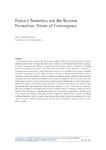Peirce's Semiotics and the Russian Formalism: points of convergence

View/
Use this link to cite
http://hdl.handle.net/2183/13421Collections
Metadata
Show full item recordTitle
Peirce's Semiotics and the Russian Formalism: points of convergenceAuthor(s)
Date
2012Citation
Culture of communication / Communication of culture, 2012: 1317-1322. ISBN: 978-84-9749-522-6
Abstract
[Abstract] It is a prevailing opinion nowadays that Saussurean semiology and Peircean theory of signs are two major semiotic schools which, although they have certain theoretical and historical background in common, are utterly incommensurable. However, it appears that the opposing extremes of Saussure’s semiology and Peirce’s semiotics seem to be reconcilable in the light of the Russian formalism— essentially a Saussurean-type semiotic school, which gained wide acclaim in the mid-20th century Europe, alongside the French structuralism. In his late paper «Oedipus in the light of folklore» Vladimir Propp, one of the formalists, explores the problem of narrative continuity in different folklore traditions. Taking the story of Oedipus Rex as an example, he describes a set of «motives» shaping the story as specific iconic units of discourse by means of which certain forms of narrative are transmitted from one historical period to another. His analysis reveals some striking similarities with Peirce’s early ideas on the nature of signs and representation, and in particular those Peirce puts forward in his «On a New List of Categories». This paper undertakes to reinterpret some of the late formalist ideas on continuity in terms of Peirce’s semiotics. The brief account it presents has a double aim: (1) to show the possibility of building a case where Peirce’s basic semiotic ideas might actually be applied as efficient tools in analysis of different traditional discourses, and (2) to enable us to put some basic formalist analytical categories in the wider context of Peirce’s semiotics, making purely structural aspect of meaning a particular case of Peirce’s theory of signs
ISBN
978-84-9749-522-6





